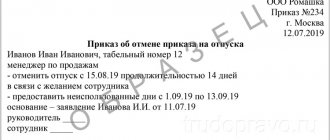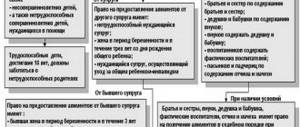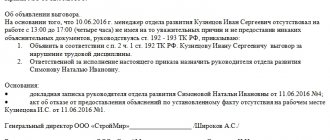According to Russian legislation, each spouse must provide for a common minor child. When one parent leaves the family and does not want to voluntarily support the child, the second is given the right to officially force the first parent to do so.
So, if you receive a court order for alimony, what should you do next? The material below will answer this question.
How long does it take to file documents with the court after a divorce?
In order for child support payments to be ordered from a parent through a court order, the applicant must:
- Draw up an application and provide it with supporting documents according to the rules of Art. 122-127 Code of Civil Procedure of the Russian Federation.
- Submit an application to the magistrate's court at your place of residence or the location of the future payer (this type of collection of alimony allows for alternative jurisdiction at the choice of the applicant).
- As a result, the court will make one of the following decisions:
- issuance of a court order for alimony;
- notification to the applicant about the cancellation of the court order due to the presence of objections from the defendant - in such a situation, the claimant will be obliged to re-apply to the court, but through a statement of claim, and defend the child’s right to alimony in a court hearing.
You can submit an application to the Magistrates Court in the following ways:
- by sending registered mail to the address of the court district;
- in person - through the court office (where the specialist receiving the application is obliged to put a mark on the applicant’s copy on the date of receipt of the documents and his signature).
When writing an application for an order, indicate:
- Name of the court and its location.
- The plaintiff is referred to as the “claimant” or “applicant” indicating his full name, home address, and contact phone number.
- The defendant is referred to as the “debtor” with similar information.
- The name of the application is “Application for the assignment of alimony for the maintenance of a minor child through the issuance of a court order.”
- The main part, including:
- description of the basis for the alimony claim (presence of a child (children) in need of alimony, lack of material support on the part of the debtor);
- The alimony requirement itself is the establishment of monthly payments for child support in accordance with Art. 81 of the RF IC (i.e. shared withholding of alimony from the defendant’s income).
- List of attached documents (in copies):
- claimant's passport;
- debtor's passport (if available, but not required);
- birth certificate of the child (and if the child was born out of wedlock - a certificate of paternity or a similar court decision confirming the relationship with the future payer);
- certificate of divorce (if the spouses are divorced);
- documents or certificates confirming the defendant’s income (certificate of salary from the place of work, certificate of receipt of a pension, etc.).
- Applicant's signature and date of application.
A court order for alimony is a writ of execution. Bailiffs and alimony proceedings completely identify these concepts:
- if the applicant files a full-fledged claim for the recovery of alimony, the result of the court’s consideration is a court decision and a writ of execution (on a special greenish form) - i.e. 2 documents;
- if the applicant applies for alimony by issuing a court order, the result of the court’s consideration is 1 document - a court order (which is also a writ of execution).
After receiving such a document in court, the claimant has the right to do the following:
- Submit a court order to the territorial department of the Federal Bailiff Service (UFSSP) to initiate enforcement proceedings for the collection of alimony (according to paragraph 8 of Article 30 of the Federal Law dated 02.10.2007 No. 229-FZ “On Enforcement Proceedings”, the period for initiating proceedings is 3 days from the date receiving the corresponding application).
- Independently take the order to the place of work of the future payer to immediately begin withholding alimony.
Of course, the quick prospect of receiving alimony is tempting, but the first method - cooperation with bailiffs - is much safer and more effective than the second, for several reasons:
- firstly, the human factor cannot be excluded anywhere: the document may be lost, damaged by accounting employees, and the claimant will have to restore the duplicate independently, also through the court;
- secondly, when the debtor changes his place of work or is fired, the claimant will also have to look for a new place of employment, and without the appropriate authority this will not be possible, as a result, turning to bailiffs will still become inevitable;
- thirdly, only bailiffs can take enforcement action against debtors when alimony debts arise, which alimony recipients often face.
- Agreement establishing alimony. This document is voluntary and is concluded between the former spouses by their mutual consent. The text of the document must indicate the amount of alimony, as well as the terms and methods of payment. The agreement must be signed by both parties and notarized, otherwise it will be considered void, that is, it cannot give rise to any rights and obligations for the parties.
- Performance list. Issued by the court after consideration of the case in the general manner. As a rule, in the general procedure, claims for alimony are considered in cases where other issues are subject to resolution in the same court, for example, the issue of establishing paternity; in other cases, proceedings are carried out by order.
- Court order. A document issued by the court after consideration of the case in writ (simplified) proceedings (without trial and the presence of the parties).
According to the law, this is a court order that a judge makes in cases of filing an application for alimony, subject to the following conditions:
- the amount of the claim does not exceed five hundred thousand rubles;
- the court will not resolve other issues related to alimony, for example, issues of challenging or establishing paternity and other issues, in accordance with the Civil Procedure Code.
In order to receive this document, the parent left with minor children needs to draw up
statement of claim to court
.
It is important to include all the necessary information:
- The name of the court in which the claim will be filed;
- Details of the plaintiff (recipient of alimony) and defendant (payer of alimony): full name, date of birth, passport details, registration addresses and places of actual residence, contact numbers;
- Place of work of the payer (if it is known to the applicant);
- Amount of claim;
- Description of the circumstances of the case;
- Statement of the plaintiff’s demands, as well as the circumstances justifying them;
- List of attached documents;
The claim must be accompanied by a receipt for payment of the fee, as well as other documents necessary for the court to consider this case:
- copies of passports of the plaintiff and defendant (if any);
- birth certificates of all minor children;
- certificate of divorce;
- document acknowledging paternity (if available);
- other documents confirming the information specified in the application.
The state fee in such a case must be paid in the amount of 50% of the amount payable when considering similar cases in the general manner. The amount of state duty in 2021 is established by Article 333.19 of the Tax Code of the Russian Federation.
We suggest you read: Improper execution of an employment contract fine
A parent who has custody of minor children has the right to apply to the court at any time before they reach the age of eighteen. No statute of limitations applies to this situation. Moreover, if the applicant can prove that he took pre-trial steps to obtain child support, but the debtor evaded, then the court can collect alimony from him for an earlier period, but within three years.
In practice, there are often situations when, after a court has made a decision, the debtor decides to voluntarily transfer or transfer to the recipient the amounts accrued by the court. In such cases, there is no need to take a court order anywhere. However, the original of this document must still be preserved in case the debtor at some point changes his mind and ceases to fulfill his obligations to support the children.
If the debtor initially refuses to pay, then immediately after receiving the court order, the plaintiff must contact the bailiffs. In addition to the original order, the bailiffs will need to provide a statement written by the recipient of alimony, and you can also attach copies of other documents or information that will help you quickly find the debtor, establish his income and existing property.
The application submitted to the bailiff service must contain the following information:
- Full name, registration address and place of residence of the applicant, his passport details, contact phone number and email address if available;
- Full name, registration address and place of residence of the debtor, his contact numbers, passport details and other available information;
- The operative part of the order;
- Bank details of the applicant, according to which the transfer of monetary penalties (alimony) will be carried out;
- Date and signature of the applicant.
The application and the documents attached to it, including the court order, are transferred to the office of the SSP, after which the case is entrusted to one of the working bailiffs. If the applicant finds it difficult to independently draw up and submit the relevant documents to the SSP, he can use the help of a qualified specialist. But for this he needs to issue a power of attorney certified by a notary.
Documents can be taken to the SSP in person or through a representative, or they can be sent by mail, but in this case, it is better to do this in a valuable letter with a list of the contents and notification of receipt by the addressee.
If within 10 days after the order is issued the defendant does not raise any objections, then the order comes into force. And here the question arises - where to send the document?
independently send a court order to the organization where the ex-husband is employed (an important clarification: the paper should be taken to the accounting department). In this case, already from the parent’s first salary, the employer will deduct a certain amount in favor of the child; independently take the document to the FSSP, where the bailiff will collect alimony payments (since this is his job)
What it is?
The peculiarity of the order is that it is endowed with the force of a writ of execution , that is, it is essentially an analogue of a writ of execution. According to Art. 121 of the Code of Civil Procedure of the Russian Federation, the order is accepted by the judge only if the amount of money to be collected does not exceed 500 thousand rubles (more information on the basis of what and how the amount of alimony is calculated can be found here).
To submit it, the plaintiff must know the place of work of the future alimony payer and his earnings (they are indicated in the application).
Contents of the document
Contents of the court order:
- personal data, contacts of the parties;
- place of work of the debtor (if known);
- details of all children (full name, date of birth);
- monthly alimony amounts and payment terms;
- the amount of state duty for the payer.
Explanation of what matters cannot be resolved with him
The order of the magistrate is a unique document that is intended to quickly resolve the issue of collecting alimony. If the plaintiff or defendant insists on merging the case of claiming alimony and other cases (for example, deprivation of parental rights, challenging paternity, etc.), then the case cannot be resolved by order, since a trial is required.
In all other cases, the order is adopted without a trial or hearing of reports from the parties. With the help of this writ of execution, it will also not be possible to recover a fixed amount of money in the form of alimony (only a percentage of the defendant’s earnings or other income).
Important! Writ proceedings are a simplified procedure for obtaining alimony. However, it is possible only in the simplest cases, when parents do not have serious disagreements regarding the maintenance of their children.
From special publications by our experts, you will also learn what to do if a man does not recognize paternity and how to properly file a claim to establish it and assign alimony.
Claim or order: what's the difference?
A court order is not the only way to recover child support from a parent. Sometimes a person defending the interests of a child should contact the justice authorities with a statement of claim and seek child support payments through a more complex procedure. What is the difference between writ and claim proceedings, what is applied and when? Let's try to figure it out.
Whether it will be necessary to request the issuance of a court order or to file a statement of claim depends primarily on the existence of a dispute between the claimant and the payer. For example, on whether the debtor disputes his paternity. If he denies it (does not recognize the child and paternity has not been officially established), then it is impossible to apply to the court to issue a court order using a simplified procedure. In this case, you must file a claim with two requirements:
- Establish paternity of a citizen.
- Assign alimony in favor of the new child.
Only a district court (of general jurisdiction) has the right to consider such applications.
If there are other disputes between the defendant and the plaintiff, for example about the amount of alimony, then legal proceedings are also opened, but the application will be submitted not to the district court, but to the magistrate. In this case, the trial becomes adversarial, that is, both parties are called to a hearing, during which they have the opportunity to defend their point of view.
For example, a poor father will be able to provide evidence that the required amount of alimony is excessive: citing a modest income, the presence of other children, or the need to financially support elderly parents. And the mother has the right to try to disclose additional sources of income for the “poor” father.
But if the applicant for the order simply kept silent about the existing dispute, then he will have wasted his time on this procedure. The defendant has 10 days from the date of the order to inform the judge of his objections. After this, the court order will be canceled, and the parties will have to resolve all disagreements regarding alimony within the framework of the lawsuit.
In addition, in addition to the presence of controversial issues, writ proceedings are also impossible if:
- it is necessary to involve other persons in the process who are interested in the outcome of the case;
- the alimony resident lives outside the Russian Federation;
- the debtor's whereabouts are unknown.
Contents and explanation
Such an order must contain the following information:
- full name of the claimant and debtor;
- the territory of residence of the citizen collecting alimony payments;
- territory of residence of a citizen obligated to pay alimony payments;
- place of work of the alimony obligee;
- full names of the children to whom child support should be transferred;
- amount (share) of alimony;
- deadline for collecting funds.
It is worth indicating directly in the application for the issuance of the document that the parties do not have an agreement on alimony. Attached is a list of documents that prove the relationship with the debtor (birth certificate, certificate of family composition) and, for example, the fact that the child lives with one of the parents (extract from the house register).
A marriage certificate is attached. The existence of a marriage does not limit the obligation to pay alimony. The second parent also requests information about the debtor’s income in the organization in which he works.
IMPORTANT! It is possible to recover not a specific amount of alimony, but rather a share of the salary of the alimony obligee. Because in the first case, it is necessary to further clarify certain circumstances, and for this the parties will have to be summoned to trial.
Where should I submit my claim?
Since April 20, 2006, I have been in an officially registered marriage with Anatoly Sergeevich Kolbaskin, born on August 4, 1989. Two children were born in the joint marriage:
- Kolbaskina Elena Anatolyevich, born 05/05/2011;
- Kolbaskin Valentin Anatolyevich, born on February 24, 2015.
Court order for alimony
Since July 2021, my children and I have been living separately from my ex-husband in an apartment that belongs to me and is registered in my name. The children are completely dependent on me. I am the only person financially providing for the children, and the defendant does not take any part in the process.
Anatoly Sergeevich Kolbaskin has no other children. During the negotiations, it was impossible to reach agreement on the payment of alimony for children under the age of majority. In addition, notarized consent for alimony payments and other types of material and financial assistance to children was not concluded. Currently, Kolbaskin does not make payments under writs of execution.
Based on Article No. 80 of the IC of Russia, both spouses are responsible for the maintenance of common minor children. When implementing this law unilaterally, the party financially providing for the children has the right to demand alimony payments from the defendant in court.
Based on Article No. 81 of the IC of Russia, the absence of various legal agreements between former spouses on the payment of alimony allows the court to recover monthly funds from the second spouse in favor of the plaintiff, depending on the income of the second parent and the number of common children. So, in the case of two children, one third of the funds is withheld from the defendant’s earnings.
In accordance with the information presented, as well as on the basis of articles No. 80-81, 106-107 of the RF IC, articles No. 123-124 of the Code of Civil Procedure of Russia,
We suggest you read: How to determine the contract price
To issue a court order for the recovery of alimony from Anatoly Sergeevich Kolbaskin, born on August 4, 1989, a native of Moscow, in my favor for maintenance
- Kolbaskina Elena Anatolyevich, born 05/05/2011,
- Kolbaskin Valentin Anatolyevich, born 02/24/2015
in the amount of 1/3 of all official earnings and other sources of income, starting from the day the application is submitted until the child turns eighteen years old.
Application:
- Copy of marriage certificate
- Birth certificates of children
- A copy of the birth certificate of Shevchuk E.D.
01/17/2021 Kolbaskina M. S.
Court hearing
The claim is filed in the magistrate's court at the plaintiff's place of residence.
The judge alone, without trial or invitation of the parties, will review all the submitted documents and issue a court order within five working days if, when submitting documents, the plaintiff is guided by the norms of the current laws of the Russian Federation.
If the applicant incorrectly draws up the claim (does not include all the necessary information), does not attach the necessary documents to it, does not pay the state fee, or pays it in a smaller amount, and also violates other requirements established by the Code of Civil Procedure of the Russian Federation, the judge will refuse to accept this claim and return the documents. In this case, the applicant, after eliminating all deficiencies, will have the right to resubmit documents for consideration.
Jurisdiction of cases regarding claims for alimony is assigned to courts of general jurisdiction (Article 22 of the Code of Civil Procedure).
Geographically, this may be the court at the place of residence of the claimant or the place of registration of the debtor. The applicant himself decides where it is more convenient for him to apply. Justices of the peace are distributed among precincts. The registration address (yours or the debtor’s) determines which court district will deal with the alimony case. Documents are sent there with a request to issue an order.
Not only the second parent of a minor child has the right to write an application for an order. The initiators of this production may be:
- his guardian (or trustee);
- representative of the trustee body;
- management of the educational or medical institution where the child is placed.
When submitting an application, you need to replenish the treasury with a small state fee of 100 rubles (Article 333.19 of the Tax Code). But it will be the debtor who pays it later, and not the applicant, since the latter turns to the magistrate in order to protect the interests of the child, and not his own (for such requirements, applicants are exempt from the fee). The court order sent to the alimony holder will indicate the amount of the fee to be paid.
Results
The court order can be transferred for execution and collection of alimony...
- to the accounting department at the place where wages, scholarships, pensions, social benefits, and other income are calculated;
- to the Bailiff Service at the place of residence of the alimony payer.
The recipient of alimony payments must submit to the authorized official an application for the calculation and withholding of funds, attaching a court order to it.
Oddly enough, executing a court order can be an even more complex process than a trial. Especially if the payer begins to hide income and refuses to make payments for the child. Or if there are violations on the part of the administration of the enterprise (organization, institution) - violation of deadlines, errors in calculations, loss of documentation.
If you encounter difficulties in the process of interaction with officials, if you need legal assistance or advice, you can always seek free legal advice from the lawyers of our portal.
- Due to frequent changes in legislation, information sometimes becomes outdated faster than we can update it on the website.
- All cases are very individual and depend on many factors. Basic information does not guarantee a solution to your specific problems.
This is important to know: Judicial practice of the RF Armed Forces in cases of alimony collection
That's why FREE expert consultants work for you around the clock!
- via the form (below), or via online chat
- Call the hotline:
Procedure for issuing an order
After receiving the application, the magistrate issues a “maintenance” order within 5 days. Previously, he establishes the indisputability of the applicant’s claims - on the basis of the submitted paper and the documents attached to it. The parties are not present at the court hearing and do not defend their point of view. The decision is made without them, since it is assumed that there are no disagreements between them.
An order is issued only when it is known:
- residence address of the alimony payer (in the territory of the Russian Federation);
- his place of work (on the territory of the Russian Federation);
- amount of income (for example, the ex-wife does not prove that the child’s father has sources that he hides).
Writ proceedings will not be opened even if the child’s mother demands payment of alimony from a person not included in the certificate as the father. Refusal will follow both in the case where another citizen appears, and if there is a dash. A court order cannot be issued against a man whose paternity has not been established. This issue is beyond the competence of the magistrate, so you will have to appeal to the district court.
The order is drawn up in two copies, each of which is personally signed by the judge and certified by a seal. One remains in the judicial department, the other is used as a writ of execution: according to it, the claimant receives the right to force the alimony provider to pay child support in the specified amount.
The procedure for collecting alimony through the SSP
Based on the documents received, the bailiff will issue a decision to initiate enforcement proceedings and send copies of it to the defaulter, as well as to the applicant.
Next, the bailiff must send requests to the relevant authorities (pension fund, tax office, insurance companies, banks, Rosreestr, traffic police, and so on) to determine the income and property of the debtor. The bailiff also visits the alimony defaulter at an address or place of work known to him and holds a conversation with him.
The court order is transmitted to the management of the organization in which the debtor works, which, in turn, must either begin to transfer funds withheld from his wages to the recipient of alimony, or, if the debtor no longer works there, give an official response to the bailiff within three working days, and also provide information known to him about the new job or location of the debtor.
If the debtor does not work anywhere, but has property, the bailiff can describe this property and send it to auction. Willful defaulters who not only do not comply with court orders, but even go into hiding, may be put on the wanted list. They may also be subject to administrative or even criminal penalties.
The desire for a peaceful resolution of all disputes that arise between former spouses is the key to a calm and happy life not only for the participants in these disputes, but also for their minor children, who are not guilty of anything, do not know how to provide for themselves and stand up for themselves.
Cancellation of a court order is probably the easiest way to temporarily relieve oneself of alimony obligations. And it is temporary due to the fact that most likely the claimant will repeat the attempt to assign funds for the maintenance of the child through a full-fledged claim proceeding and alimony will eventually be assigned.
Article 129 of the Code of Civil Procedure of the Russian Federation provides for the debtor’s right to challenge (
cancellations
) document on the assignment of child support within 10 days from the date of its receipt.
Based on the norms of this article, the procedure for canceling a writ of execution should be as follows:
- Receiving a court order (according to the rule of Article 128 of the Code of Civil Procedure of the Russian Federation, the court is obliged to send a copy of it to the debtor party).
- We comply with the deadlines for appeal (cancellation) - within 10 days you must send an objection to the court.
- If the deadline for cancellation is missed, simultaneously with the objections, a petition is sent to restore the appeal period (Article 112 of the Code of Civil Procedure of the Russian Federation) and a valid reason for this is indicated (for example, the court sent an order late, being on a business trip or undergoing treatment, etc.).
- As a rule, when objections are received from the defendant, the court also cancels the order without scheduling a hearing on the case, the parties are notified about this, and the claimant is additionally explained his right to re-apply to the court in the course of the claim proceedings for the assignment of alimony.
The judge's order has the force of a writ of execution, therefore, having received it, the interested person can proceed to active actions. If the alimony payer officially works, then the document can be sent directly to the accounting department of the enterprise. Then, from the debtor’s next salary, deductions for child support will begin to come.
Another option is to involve bailiffs in collecting alimony by contacting the FSSP. Then enforcement proceedings will be opened, and department employees themselves will take care of withholding part of the debtor’s earnings. If it is not known where he is, then employees of the local police department are already involved in the case. They will begin searching for him at the request of the bailiffs or the recoverer of sums of money.
We invite you to read: Collection of alimony based on a court order || Court order for the collection of alimony for marriage
After receiving a court order to collect alimony, you need to decide on the organization that will enforce it. The law provides for the possibility of sending a writ of execution to several authorities:
- the debtor's employer;
- structural division of the FSSP of Russia.
If it is known where the debtor works, then the court order can be submitted directly to the accounting department of the enterprise where the person obligated to pay alimony is employed. This possibility is provided for in Article 9 of the Federal Law “On Enforcement Proceedings”. The original writ of execution and an application are submitted to the accounting department, which must indicate the bank details of the claimant if the funds are planned to be received on an account or card, or the address of the claimant if alimony will be paid by postal transfer.
- The application form and sample can be viewed here.
Example 1
If the debtor’s place of work is not known, then the writ of execution can be presented for enforcement to the bailiff service. The court order should be presented to the district department at the debtor’s place of residence. In some territorial bodies of the FSSP of Russia, special departments have been created that deal exclusively with the collection of alimony.
You can find out about this on the official websites of the territorial bodies of the Bailiff Service, or by calling the hotline. In addition, you can send a court order to the Office of the territorial body of the FSSP of Russia, from where it will be transferred to the appropriate department for execution.
When presenting a court order, you will need to write a statement, which, in addition to information about the claimant and his bank details, may contain information about the debtor - his place of work, property, bank accounts, etc.
Alimony for minor children is collected through the court in two ways:
- a statement of claim is filed, the trial is held as usual;
- a special application is drawn up to obtain a court order for the collection of alimony. Then a special (simplified) legal procedure is applied.
The second method is faster and easier, but it cannot be used in all cases. We'll figure out.
You can apply for a court order if the defaulter is listed as a parent on the birth certificate.
But the order will not be issued if:
- paternity (maternity) is disputed, or third parties must be invited to court;
- the defaulter pays on other writs of execution (for example, alimony for children from a first marriage);
- the debtor does not live in our country, but abroad.
In addition, the writ only recovers a percentage of the defendant's earnings. To collect alimony in the form of a fixed amount (for example, 20 thousand rubles per month), you must submit an application. This situation is considered in a full court hearing.
As you can see, the procedure for obtaining alimony by order of a judge can be used if the matter is obvious and does not concern the interests of other people other than the applicant and the debtor.
Court hearing
Rubric “Question-Answer”
Are there consequences if the writ of execution is revoked?
The law does not prohibit the withdrawal of a sheet that has been submitted to the bailiffs. This is regulated by the federal law “On Enforcement Proceedings,” namely Article No. 46.
In addition, it should be clarified that even if the writ of execution is revoked, the resulting debt will not be written off, and all monthly payments must be made according to the schedule established in the order. In other cases, bailiffs have the right to re-initiate forced collection for a period that does not exceed three years, even if the sheet has been withdrawn.
This allows the applicant to prove that even with a verbal agreement on financial assistance, payments were never received. Thus, the law “thinks” ahead for its citizens and acts as an insurance policy.
If court officials do not collect alimony, what should you do?
Every citizen is also protected by law from the inaction of bailiffs. So in ch. No. 25 of the Code of Civil Procedure of Russia contains rights and obligations, in case of violation of which you can appeal against the actions or inaction of the bailiff. You can also contact a higher authority.
The appeal process, as well as the claimant’s requirements, depend on what violations occurred. Note that there can be many of them, so it is difficult to list them. You should read the chapter mentioned above.
Is there a difference between alimony payments when people are married and after a breakup?
There is no such difference at all. That is, it does not matter whether the marriage is dissolved or not. The applicant has the right to demand financial assistance for a joint child. At the same time, the payment procedure, amount, and collection process by court order are the same.
Cancellation of a court order
Unfortunately, a court order has one significant drawback: it is easy to cancel. To cancel a document, the debtor needs:
- within 10 days after receiving a copy of the order, prepare written objections;
- forward them to the magistrate.
Having received the alimony provider’s objections, the judge does not check their validity, but cancels the court order and issues an appropriate ruling. Within 3 days, copies of it are sent to the debtor and the claimant. The applicant, at whose request the order was issued, is explained his right to claim child support through the claim proceedings. If no objections are received, a separate copy of the court order is sent to the claimant.
The objection is submitted to the same magistrate who prepared the order. In the application, the debtor states:
- that he received the order (indicates its details);
- that he has objections;
- What exactly do I disagree with?
In conclusion, the applicant asks to cancel the document, puts the date and his signature.
After the court order is canceled, alimony payments are suspended. To renew them, the claimant must file a claim in the district court. If the case is decided in his favor, then alimony will be calculated during this “downtime”.
It is only possible to return illegally awarded alimony for the last 3 years. It does not matter whether they were appointed by order or court decision. The law provides a few grounds for the return of amounts already paid (Article 116 of the Family Code):
- the alimony agreement under which they were paid was declared invalid by the court, since the payer was forced to enter into it through violence, threats and deception;
- the recipient was convicted of deliberately providing false documents or reporting false information, on the basis of which a court decision was made or an order was issued to collect alimony;
- alimony was collected based on a fake resolution, agreement or writ of execution.
This is an exhaustive list of circumstances under which you can expect a refund.
How to cancel?
If you disagree with the very fact of calculating alimony or the amount of financial support, you can appeal the order. As mentioned above: within ten days from the receipt of a copy of the order, you can achieve the cancellation of enforcement proceedings by simply sending your objections (application). This right is provided for in Art. 129 Code of Civil Procedure of the Russian Federation. For the judge, the presence of objections will be a signal that the case requires more serious consideration.
An application to cancel a court order includes:
- contacts of the parties;
- number of the court order and the date of its issuance;
- grounds for cancellation;
- request to cancel the order;
- date and signature of the applicant.
Once the application to set aside is recorded, the judge will usually set aside the order . Because of this, enforcement proceedings are also stopped, that is, the document cannot be transferred to the accounting department at the debtor’s place of work. After this, the applicant has no choice but to collect alimony not through an order, but through a lawsuit.
The application is submitted to the same magistrate who considered the wife’s application and signed the court order. In this case, the state duty is not paid. As an attachment, a copy of the previously adopted executive document is provided, as well as a copy of the applicant’s passport.
Attention! You can attach evidence to the document, for example, copies of receipts that confirm regular financial support for the family, DNA test results that cast doubt on paternity, etc.
When the order is lost
If the claimant has lost the received copy of the court order, he has the opportunity to issue a duplicate of the document. This must be done even if a copy has been preserved, since it means nothing to bailiffs: they only work with originals.
To restore the order, the claimant writes an application addressed to the same judge who issued it. In the appeal, he asks for a duplicate and states under what circumstances the original was lost. The fact of loss is confirmed by documentation, for example a certificate from the police.
The statement briefly outlines the circumstances of the case in which the lost document was issued. The submitter of this paper reports that the order has not yet been fully executed. Based on the claimant’s application, the court makes a ruling either to provide a duplicate or to refuse it. The refusal can be appealed within 15 days.








